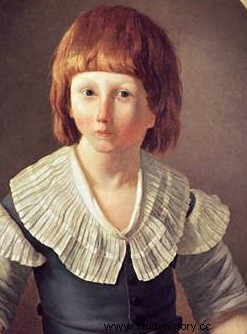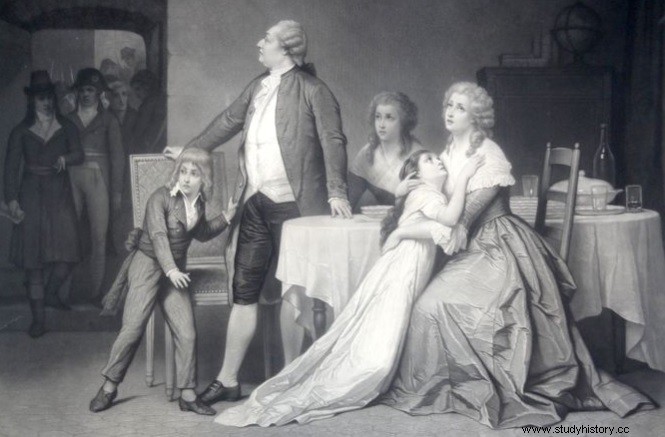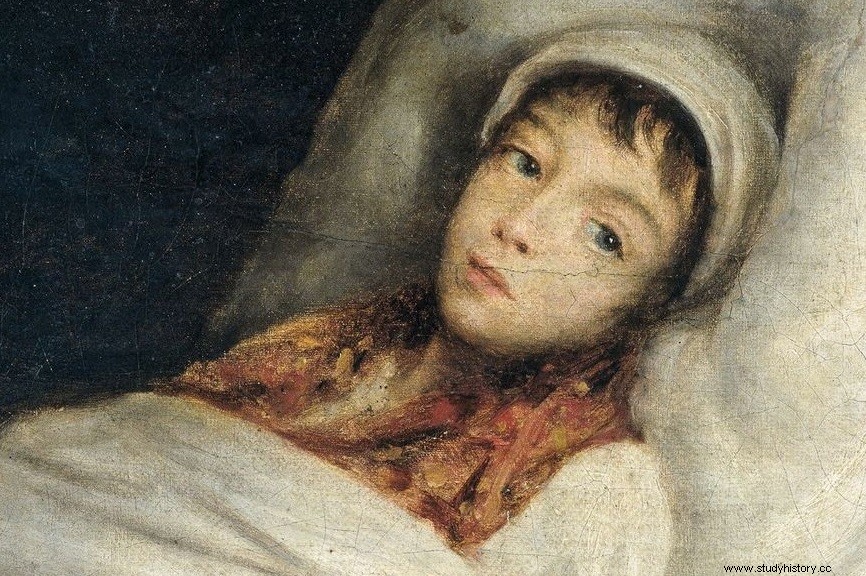 Louis XVII (1785-1795), Dauphin of France, is the second son of Louis XVI and Marie-Antoinette. After the execution of his father, he is declared king by the noble emigrants under the name of Louis XVII. Nevertheless, his reign is only theoretical. The child remains imprisoned in the Temple, where he dies in June 1795. He is then buried secretly in the Sainte Marguerite cemetery, so the rumor suggests that the dolphin escaped. The mystery hovers for two centuries, but in April 2000, DNA tests made it possible to remove doubt about the identity of the "prisoner of the Temple", who was indeed the son of Marie-Antoinette and Louis XVI.
Louis XVII (1785-1795), Dauphin of France, is the second son of Louis XVI and Marie-Antoinette. After the execution of his father, he is declared king by the noble emigrants under the name of Louis XVII. Nevertheless, his reign is only theoretical. The child remains imprisoned in the Temple, where he dies in June 1795. He is then buried secretly in the Sainte Marguerite cemetery, so the rumor suggests that the dolphin escaped. The mystery hovers for two centuries, but in April 2000, DNA tests made it possible to remove doubt about the identity of the "prisoner of the Temple", who was indeed the son of Marie-Antoinette and Louis XVI.
The theoretical reign of Louis XVII
Second son of Louis XVI and Marie-Antoinette, Louis Charles (1785-1795) was born in Versailles. Duke of Normandy, he became Dauphin on the death of his older brother in 1789, then Prince of France in 1790. European powers recognize him as royal successor under the name of Louis XVII. However, this does not reign. His uncle, Count of Provence, assumed the theoretical regency and monarchists advanced counter-revolutionary proclamations in his name.
The royal family locked up in the Temple tower
 Following the riots of June 20, 1792, the people understand that the king will not compromise and dissatisfaction with the royal family grows. On August 10, Louis XVI is definitively deposed. He is imprisoned with his family in Paris in the Tour du Temple, built by the Templars in the Middle Ages. This square building has four floors. The royal family is initially housed in an annex tower, while the main building is being prepared. On September 29, Louis XVI can finally live there. It occupies the second floor.
Following the riots of June 20, 1792, the people understand that the king will not compromise and dissatisfaction with the royal family grows. On August 10, Louis XVI is definitively deposed. He is imprisoned with his family in Paris in the Tour du Temple, built by the Templars in the Middle Ages. This square building has four floors. The royal family is initially housed in an annex tower, while the main building is being prepared. On September 29, Louis XVI can finally live there. It occupies the second floor.
A month later, the dolphin joins his father, while the queen takes up residence on the third floor. When the trial of Louis XVI begins, on December 11, the dolphin lives with his mother, his sister and his aunt. He did not see his father again until January 20, 1793. Six months later, on July 3, he had to separate from his mother. He then goes down to his father's old room, where he lives isolated.
A popular education
After the death of his father, Louis XVII was placed under close surveillance. He is educated like a child of the people by the shoemaker Simon and his wife. He teaches her to deny her parents, to drink, to swear and to sing revolutionary songs. The state of health of the young child, victim of bone tuberculosis, deteriorates rapidly and the deplorable hygienic conditions in the dungeon accentuate his illness. After the departure of his educators, he is left to himself, locked in an unsanitary room, without care. After the death of Robespierre in January 1794, he remained detained in the Temple, in better conditions.
The death of Louis XVII
 Louis XVII died in prison in 1795. He was then plagued by tuberculosis and psychologically broken. His death sparked heated controversy. Some dare to believe that the assertion of his death is false, that he fled and that the corpse of the Temple is that of another child. Many rumors claim that Louis XVII found refuge in Vendée. Thus, about thirty suitors claim their right to reign and begin legal proceedings. A certain Naundorff even made himself Duke of Normandy in 1824 and his descendants have, on several occasions, seized French justice to assert their alleged rights.
Louis XVII died in prison in 1795. He was then plagued by tuberculosis and psychologically broken. His death sparked heated controversy. Some dare to believe that the assertion of his death is false, that he fled and that the corpse of the Temple is that of another child. Many rumors claim that Louis XVII found refuge in Vendée. Thus, about thirty suitors claim their right to reign and begin legal proceedings. A certain Naundorff even made himself Duke of Normandy in 1824 and his descendants have, on several occasions, seized French justice to assert their alleged rights.
These escape rumors seem untrue, in light of a recent study of the alleged heart of the child, kept by several owners. In 2000, genetic specialists compared his heart with that of his mother. The results confirm that the organ belonged to Louis XVII and put an end to suspicions of escape. The young king is indeed dead in the Temple.
Bibliography
- From Philippe Delorme, Louis XVII:the biography. Via Romana, 2015.
- From Hélène Becquet, Louis XVII. Perrin, 2017.
